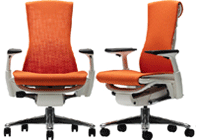
Ergonomics is a big deal these days; everything from the keyboard you type with to the television controller that sits in your hand is shaped for comfort, yet Herman Miller has gone one step further.
The slim back of the company’s new Embody chair forms a fascinating visual antidote to usually bland office furniture. However, it also performs a key task in providing the user with the ability move naturally while seated.
Janet Barnes, senior product manager, seating, for Herman Miller, explains, “The way in which the [seat] back is constructed – the H-flexors and the thinness – it allows you to move your shoulders and your torso much more than any other chair to the point that it takes pressure off the diaphragm and allows us to take more efficient breaths.”
The design of the Embody is a credit to the understanding of how the human body moves, even when we think we are sat stationary at our desks.
Rotation points within the seat and back, and the base of the back remain fixed relative to the seat; encouraging the body to move naturally into the most positive seated postures.
The new seat is not foam or suspension, but ‘pixelated’ support, which is said to allow for better circulation in the lower body, leading to a reduced resting heart rate of about ten per cent.
The inspiration is credited to the late Bill Stumpf who designed or co-designed Herman Miller’s Aeron, Equa, and Ergon work chairs, yet it is Jeff Weber who added function and form to the Embody design.
“We had a tremendous amount of direction and support from various experts,” says Jeff. “Movement is the key to good health, so their concept was to design something for people working at desks for eight hours who don’t get enough healthy support or movement from their furniture.
“I’m educated as an industrial designer, a product designer, but I would say that philosophically I’m a humanist first,” explains Jeff. “I really focus on human needs and human behaviour which evolves into a comprehensive understanding of ergonomics.” Ironically the team didn’t use the term ergonomic throughout this program due to it being a grossly misused word.
Movement is the key to good health, so their concept was to design something for people working at desks for eight hours who don’t get enough healthy support or movement from their furniture
Jeff Weber, Herman Miller
“Movement and responsiveness drove the geometry, and designing a system that is the analogue to the human body – the human spine – and the metaphysical manifestation of that evolved over much trial and error work,” states Jeff, before explaining the unique support system made possible through CAD.
“We define the support system as ‘pixels’, to use a metaphor. We believe that if we could program each one of those points to perform a certain task we could potentially design the most comfortable surface to support the upper body.
“What’s interesting about this chair is that it’s a series of variables and things like fine-tuning the seat for comfort was critical and so if you manipulate one variable it could affect the overall matrix. That’s the beauty of the technology used – the sophistication of the product is somewhat relative to the sophistication of the design tools.”
Jeff admits that he isn’t a full-blown tech geek, but acknowledges the design wouldn’t have been possible without the use of 3D design tools. “We like to tinker around in the workshop with physical matter, as opposed to digital matter, but at some point we had to transfer that physical learning into the virtual world so that we could then begin to process the engineering and having a greater level of control.
“I’m more of a Luddite than a technocrat – but I must say that we wouldn’t have been able to design and engineer this chair without the use of CAD or a number of related software.”
Herman-Miller’s internal standard CAD software is Pro/Engineer; in addition Jeff used a variety of other software in his office varying from simple two-dimensional layouts, advanced simulation and also final rendering with Rhino. Rapid Protoyping also plays a huge role in the development of new products.
“Once we’ve entered into the virtual world we do a tremendous amount of rapid prototyping to test our theory of concept. We’ll then physically manipulate the matter and then reverse engineer the data back into the CAD,” says Jeff, before referring to the vast amount of testing these physical and digital prototypes undertake. “There was a lot of virtual finite element analysis and then once we had enough information we eliminated the mistakes.”
The final product is a thing of strange beauty; space age structuring and striking materials with a central spine supporting flexors branching off on either side. “All the components are purposeful, not only aesthetically,” concludes Jeff, of what is surely a new standard in ergonomic technology.

A natural antidote to bland office furniture






